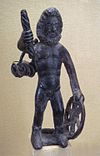- Ialonus Contrebis
-
In ancient Celtic religion, Ialonus Contrebis or Ialonus or Gontrebis was a god (or perhaps two related gods) worshipped in what are now Lancashire and Provence. He is known from three dedicatory inscriptions. One, at Lancaster, was dedicated (in the dative) to Deo Ialono Contre Sanctissimo ("to the holiest god Ialonus Contre[bis]"); another, at Overborough in Kirkby Lonsdale, to Deo San Gontrebi ("to the holy god Gontrebis").[1] In the third inscription, found at Nîmes in Provence, Ialonus was invoked in conjunction with the goddess Fortune.[2]
The name Contrebis may possibly contain a root related to Proto-Celtic trebo- 'house'. That of Ialonus may be related to the Proto-Celtic root jalo- 'clearing'.[3]
References
- ^ RIB 600 and 610, online at www.Roman-Britain.org.
- ^ L'Arbre Celtique. Ialonus
- ^ Proto-Celtic—English lexicon. University of Wales Centre for Advanced Welsh and Celtic Studies. (See also this page for background and disclaimers.)
- Miranda Green (1997). Dictionary of Celtic Myth and Legend. Thames and Hudson Ltd, London.
Celtic mythology series Supra-regional Alaunus • Alisanos • Andarta • Anextiomarus • Artio • Aveta • Belenus • Belisama • Borvo • Brigantia • Camulus • Cernunnos • Cicolluis • Cissonius • Condatis • Damona • Matrona • Dis Pater • Epona • Erecura • Esus • Genii Cucullati • Grannus • Ialonus Contrebis • Lenus • Litavis • Loucetios • Lugus • Maponos • Matres • Mogons • Nantosuelta • Ogmios • Rosmerta • Segomo • Sirona • Sucellus • Suleviae • Taranis • Toutatis • Virotutis • VisuciusBritannia Gallia Aquitania Gallia Belgica Abnoba • Ancamna • Arduinna • Arvernus • Icovellauna • Inciona • Intarabus • Iovantucarus • Ritona • Veraudunus • Vindonnus • Vosegus • XulsigiaeGallia Celtica Gallia Cisalpina Gallia Narbonensis Germania Inferior Gallaecia Categories:- Celtic mythology stubs
- Ancient Gaulish and British gods
- Tutelary
Wikimedia Foundation. 2010.


